Los Moais de la Isla de Pascua: ídolos de Rapa Nui si caminaban
.
"Moais" The Statues that Walked: solved the mistery of the monumental statues of Easter Island.
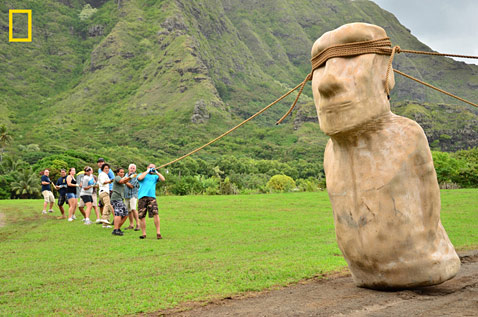
Mientras un equipo de voluntarios tira en una dirección, otro grupo al otro lado coordina, el resultado es un desplazamiento sobre la base del "moai", en este caso, una réplica a escala real de un moai de Isla de Pascua. "Camina" por un camino en Hawai, donde se llevó a cabo el experimento. El experimento, que involucró a dos grupos de balanceo de un lado a otro de la estatua, mientras que un tercer grupo la estabilizaba desde atrás, mostró que un mínimo de 18 personas podría mover el moai de 10 pies, de 5 toneladas, unos cientos de metros sin que se vuelque.
.

.
As a team of volunteers pulls in one direction and a group across from them coordinates, a full-scale replica of an Easter Island moai “walks” down a road in Hawaii, where the experiment was conducted. The experiment, which involved two groups rocking the statue from side to side while a third stabilized it from behind, showed that a minimum of 18 people could move the 10-foot, 5-ton moai a few hundred yards without it tipping over. (Sheela Sharma/National Geographic)
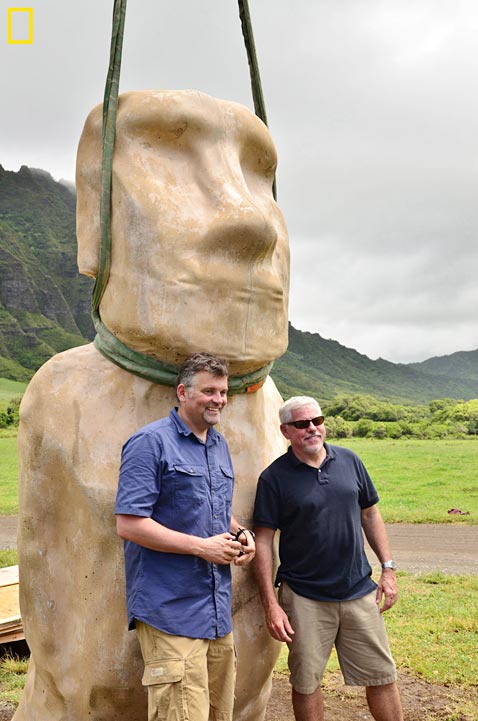
Arqueólogos de Estados Unidos comprobaron la teoría de que los moais de Rapa Nui ‘caminaron’ hasta su emplazamiento actual. Un estudio publicado por la revista National Geographic explica cómo los pascuenses lograron trasportar los enormes monumentos desde las canteras hasta su localización actual, con un sutil balanceo.
Los arqueólogos Carl Lipo de Universidad Estatal de California, y Terry Hunt, de Hawai, sostienen que las ‘barrigas’ de los moais les permiten moverse de un lado a otro, generando un movimiento parecido a una ‘caminata’. Según los científicos, para que la estatua cruce la isla ‘caminando’ basta con usar varias cuerdas y aplicarle fuerza humana. Para probar su teoría, los profesionales crearon un moai de 5 toneladas de peso, unas 85 toneladas más liviano que los reales, que logró ‘caminar’. Con la ayuda de unas 18 personas, sólo tres cuerdas y un poco de práctica, la estatua se desplazó varios cientos de metros. Su experimento corrobora la teoría del científico checo Pavel Pave, que en 1986 la quiso llevar a la práctica, aunque su estatua no logró andar sin dañarse.
Otras teorías, que Hunt y Lipo desestiman, sostienen que los rapa nui trasladaron los moais arrastrándolos o bien creando una suerte de trineos con troncos de árboles

.
"Moais" las estatuas que caminan
Las monumentales estatuas de la Isla de Pascua, tanto por lo magistral y triste, contemplandas en fila, se imponen al árido paisaje de la isla. Los Moais han sido fuente de un gran misterio desde que la isla fue descubierta por los europeos un domingo de Pascua 1722.
¿Cómo pudieron los antiguos pobladores que habitaron esta pequeña mota de tierra, la más remota isla en la vasta extensión de las islas del Pacífico, haber construido obras tan monumentales? No hay otro territorio insular de enormes y sorprendentes estatuas en todo el Pacífico.
¿Cómo pudieron los isleños haber movido tantos monolitos de varias toneladas desde la cantera del interior, donde fueron talladas, a sus puestos a lo largo de la costa? Y lo más intrigante y desconcertante de todo, si la isla tuvo una cultura desarrollada y sofisticada, como para haber producido estos maravillosos monumentos, que le pasó a esa cultura?
¿Por qué era la isla que los europeos encontraron, un erial escasamente poblado?
.
Las narraciones en la isla, cuentan una historia de devastación auto-infligida: un caso flagrante de eco-suicidio. Cuentan que la isla estaba dominada por una poderosa jefatura que ordenó el culto a las estatuas, ejerciendo un dominio brutal sobre la gente de la isla y una completa destrucción del medio ambiente, debido a la tala de un bosque de palmeras exuberantes, que una vez cubrieron la isla, para construir artilugios para movilizar más y más estatuas, que se hicieron más y más grandes.
Como la población creció a fin de sostener el culto a la estatua, con un crecimiento mucho más allá de la capacidad agrícola de la isla, estalló un círculo vicioso de guerras entre grupos rivales, y la cultura en última instancia, sufrió un dramático colapso.
.
Cuando Terry Hunt y Carl Lipo, comenzaron sus estudios arqueológicos en la isla en 2001, esperaban encontrar evidencias que respaldan estas leyendas orales. En cambio, revelación tras revelación descubrieron una verdad muy diferente. En este relato vivo y fascinante, Hunt y Lipo develan el misterio de lo que realmente sucedió en la isla, que introducen una serie sorprendente de descubrimientos arqueológicos, que los llevó a encontrar nuevas respuestas a las preguntas más desconcertantes de la historia de la isla.
Lejos de ser irresponsables destructores del medio ambiente, los habitantes de la isla de Pascua eran guardianes del medio ambiente notablemente inventivos, que elaboraron ingeniosos métodos para mejorar la capacidad agrícola de la isla. Ellos no devastaron el bosque de palmeras, y la cultura no cayór en la violencia brutal. Tal vez lo más sorprendente de todo, es que la talla y el movimiento de sus estatuas no requiere una población enorme, ni impuesto sobre sus preciosos recursos; la talla de los moais, era en realidad parte integral de su capacidad para lograr un delicado equilibrio de sostenibilidad. La isla de Pascua, resulta que, nos ofrecen un impresionante historial de gestión del medio ambiente, rica en lecciones magistrales para enfrentar los enormes desafíos ambientales de nuestro tiempo.
Rompiendo la creencia convencional, Hunt y Lipo ofrecen una comprensión radicalmente diferente de la historia de este lugar misterioso.
.
"Moais" The Statues that Walked
The monumental statues of Easter Island, both so magisterial and so forlorn, gazing out in their imposing rows over the island’s barren landscape, have been the source of great mystery ever since the island was first discovered by Europeans on Easter Sunday 1722. How could the ancient people who inhabited this tiny speck of land, the most remote in the vast expanse of the Pacific islands, have built such monumental works? No such astonishing numbers of massive statues are found anywhere else in the Pacific. How could the islanders possibly have moved so many multi-ton monoliths from the quarry inland, where they were carved, to their posts along the coastline? And most intriguing and vexing of all, if the island once boasted a culture developed and sophisticated enough to have produced such marvelous edifices, what happened to that culture? Why was the island the Europeans encountered a sparsely populated wasteland?
The prevailing accounts of the island’s history tell a story of self-inflicted devastation: a glaring case of eco-suicide. The island was dominated by a powerful chiefdom that promulgated a cult of statue making, exercising a ruthless hold on the island’s people and rapaciously destroying the environment, cutting down a lush palm forest that once blanketed the island in order to construct contraptions for moving more and more statues, which grew larger and larger. As the population swelled in order to sustain the statue cult, growing well beyond the island’s agricultural capacity, a vicious cycle of warfare broke out between opposing groups, and the culture ultimately suffered a dramatic collapse.
.
When Terry Hunt and Carl Lipo began carrying out archaeological studies on the island in 2001, they fully expected to find evidence supporting these accounts. Instead, revelation after revelation uncovered a very different truth. In this lively and fascinating account of Hunt and Lipo’s definitive solution to the mystery of what really happened on the island, they introduce the striking series of archaeological discoveries they made, and the path-breaking findings of others, which led them to compelling new answers to the most perplexing questions about the history of the island. Far from irresponsible environmental destroyers, they show, the Easter Islanders were remarkably inventive environmental stewards, devising ingenious methods to enhance the island’s agricultural capacity. They did not devastate the palm forest, and the culture did not descend into brutal violence. Perhaps most surprising of all, the making and moving of their enormous statutes did not require a bloated population or tax their precious resources; their statue building was actually integral to their ability to achieve a delicate balance of sustainability. The Easter Islanders, it turns out, offer us an impressive record of masterful environmental management rich with lessons for confronting the daunting environmental challenges of our own time.
Shattering the conventional wisdom, Hunt and Lipo’s ironclad case for a radically different understanding of the story of this most mysterious place is scientific discovery at its very best.
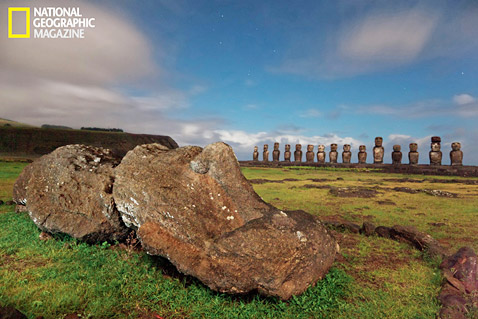 Their backs to the Pacific, 15 restored moai stand watch at Ahu Tongariki, the largest of Easter Island’s ceremonial stone platforms. Rapanui artisans carved the moai centuries ago from volcanic rock at a quarry a mile away. By the 19th century all of Easter’s moai had been toppled–by whom or what is unclear. In 1960 these moai were swept inland by a tsunami, which fractured some, left. (Randy Olson/National Geographic)
Their backs to the Pacific, 15 restored moai stand watch at Ahu Tongariki, the largest of Easter Island’s ceremonial stone platforms. Rapanui artisans carved the moai centuries ago from volcanic rock at a quarry a mile away. By the 19th century all of Easter’s moai had been toppled–by whom or what is unclear. In 1960 these moai were swept inland by a tsunami, which fractured some, left. (Randy Olson/National Geographic)
The Riddle of The Statues of Easter Island, Solved?
http://abcnews.go.com/blogs/headlines/2012/06/the-riddle-of-the-statues-of-easter-island-solved/
.
Archeologists Terry Hunt of the University of Hawaii and Carl Lipo of California State University Long Beach, have studied Easter Island for the past decade and reveal their latest theory of how the island’s iconic statueswere carved with stone tools, mostly in a single quarry, and were then transported without draft animals or wheels to massive stone platforms, or ahu, up to 11 miles away.
The following are photos and excerpts from the July 2012 issue of National Geographic.
.
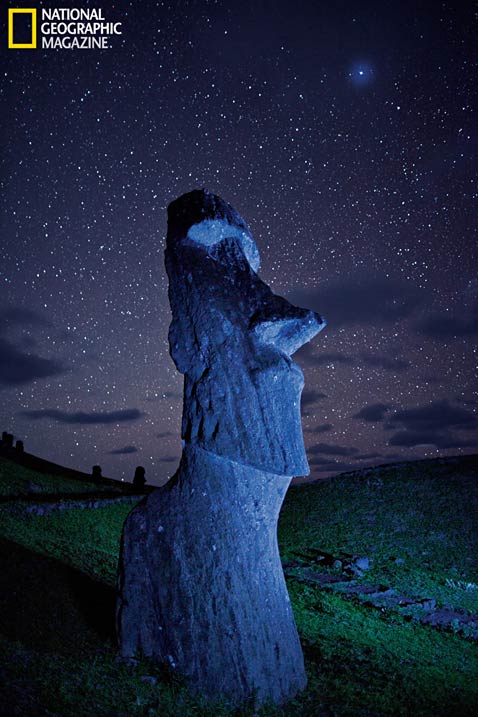
.
“The statues walked,” Easter Islanders say. Archaeologists are still trying to figure out how and whether their story is a cautionary tale of environmental disaster or a celebration of human ingenuity. (Randy Olson/National Geographic)
Easter Island covers just 63 square miles. It lies 2,150 miles west of South America and 1,300 miles east of Pitcairn Island, its nearest inhabited neighbor. After it was settled, estimates put it at roughly 1,000 years ago, it remained isolated for centuries. All the energy and resources that went into the statues, or moai—which range in height from four to 33 feet and weigh more than 80 tons — came from the island itself.
.
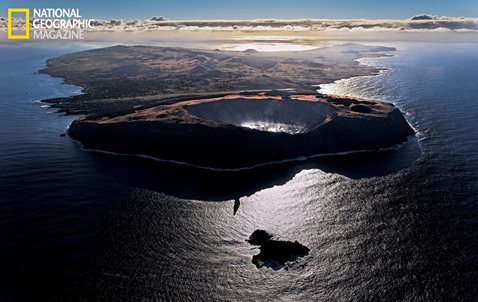 .
.
Three volcanoes, quiet now, formed Easter Island half a million years ago. It has three crater lakes but no streams; fresh water is scarce. Chile, the island’s source of fuel and most food, is 2,150 miles away. (Randy Olson/National Geographic)
Last year, in experiments funded by National Geographic’s Expeditions Council, Hunt and Lipo showed that as few as 18 people could, with three strong ropes and a bit of practice, easily maneuver a 10-foot, 5-ton moai replica a few hundred yards. In real life, walking miles with much larger moai would have been a tense business. Dozens of fallen statues line the roads leading away from the quarry. But many more made it to their platforms intact.
.
The Statues that Walked: Terry Hunt, Carl Lipo: Amazon.com: Kindle ...
www.amazon.com › ... › Ecology - Traducir esta página
When Terry Hunt and Carl Lipo began carrying out archaeological studies on the .... —Brian Fagan, Emeritus Professor of Anthropology, University of California, ...
.
http://www.redicecreations.com/article.php?id=20377
.
http://books.simonandschuster.ca/Statues-that-Walked/Terry-Hunt/9781439150313



